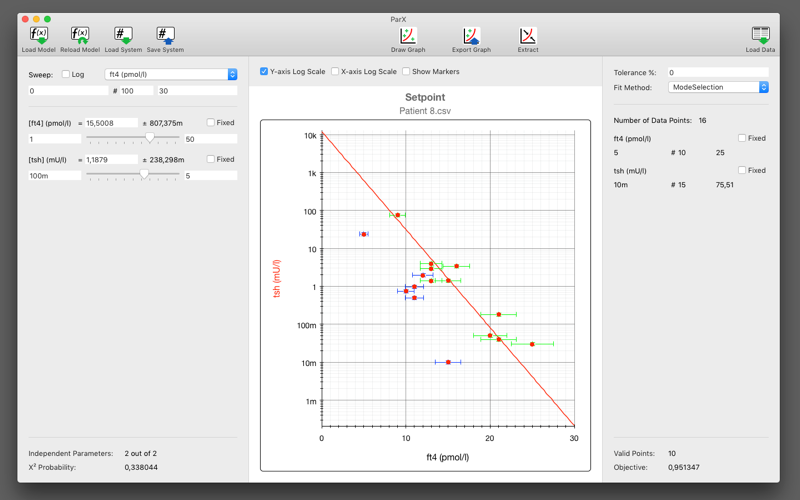
ParX is a modeling tool. With ParX you can:
• Describe your model in a simple mathematical language.
• Evaluate the behavior of your model graphically.
• Match your model against measured data.
ParX has two main applications:
Model development
Starting from theory you formulate a model to explain your measurement data. Then ParX will try to fit the model to the data by varying the parameters of the model. Often, your model is only partially correct: it can explain part of the data points, but not all off them. The fitting method in ParX is special in that it will show you where the model is valid, and where it requires more work. With ParX you can refine your model step by step.
Data fitting
Here you start with a model that is proven to be correct. You then let ParX determine the value of the model parameters that best describe your measured data. Collecting the measurement data can however be a messy process. Not all measurement errors are random noise, some data points are just plain wrong. ParX can identify and remove these outliers, as they are called, because they contain no useful information about the model.
Often real world data fitting scenarios require a mix of these two applications. That’s o.k. with ParX too. Just try it.
Analytical Models
ParX models are represented as a set of implicit equations that must be zero in the solution. There is no separation between independent and dependent variables. In combination with the availability of internal and temporary variables, this allows for a much wider scope of models without the need for internal iteration. A full set of mathematical operators and special functions is provided, as well as an abundance of special numbers and physical constants. Conditional evaluation allows for the description of regional models.
Animated Graphing
ParX is capable of producing publication quality graphs of the model. The titles and and axis labels (with optional units) support the full Unicode character set. Both linear and logarithmic axis types are provided. The model parameters are mapped to sliders that animate the model curves in real time, allowing for easy discovery of the model properties.
Robust Extraction
ParX accepts measurement data in (multi-lingual) csv formatted files. For inter-program communication a convenient JSON interface is provided as well. The input format allows for, or even encourages, the specification of error-intervals on all input variables; no artificial separation between dependent and independent variables is required. This allows the distance between the data points and the model curves to be calculated in multiple dimensions, a prerequisite for the robust extraction of strongly nonlinear models. By optimizing not only the parameter values, but also the data set, ParX delivers the best possible model-parameter estimates.



